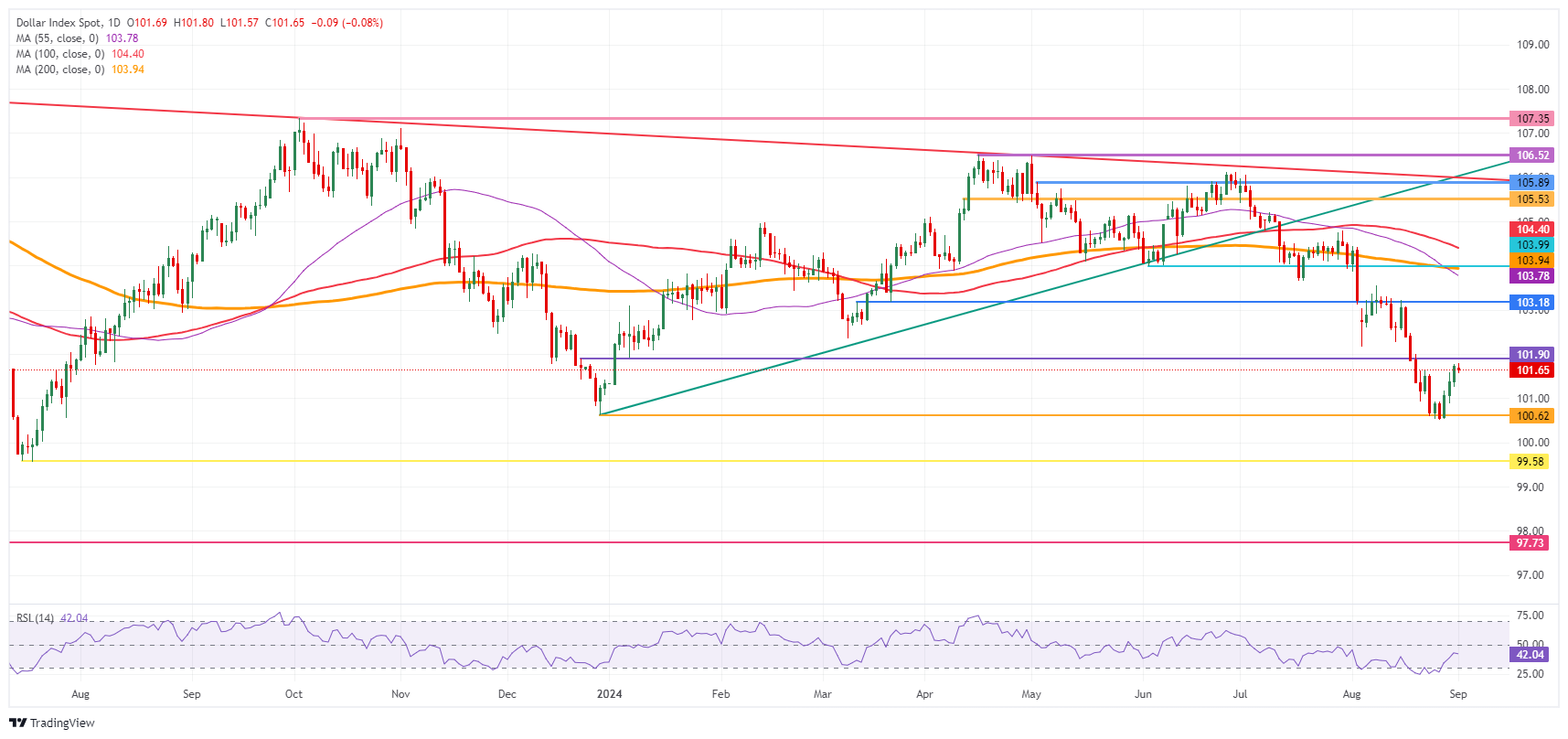US Dollar consolidates in calm start of holiday-shortened week
- The US Dollar trades broadly stable at levels near Friday’s close.
- US markets are closed on Monday due to the Labor Day holiday.
- The US Dollar Index resides in the higher 101.00 region.
The US Dollar (USD) sidelines on Monday with a very mixed picture on the quote board against most major currencies. The US Dollar kicks off this week with a calm due to the Labor Day holiday in the US, but the economic calendar will be picking up speed towards the main event on Friday. The first Friday of the month will bring the US Jobs Report, with the Nonfarm Payrolls and other wage data for markets to move on.
Apart from the all-important payroll data, the calendar will also feature the Purchasing Managers Index (PMI) data, which tends to move markets as it gives fresh clues about the state of the economy. This could mean that the US Dollar Index might have moved already substantially ahead of Friday’s main event.
Daily digest market movers: Take it easy
- US markets are closed on Monday in observance of Labor Day.
- China has warned Japan over economic retaliation over potential chip curbs, according to Bloomberg.
- On Saturday, the release of China’s Purchasing Managers Index numbers for August signaled that the contraction in the country’s manufacturing sector persists. The PMI came in at 49.1, lower than the 49.4 seen a month earlier.
- Equities are struggling across the board, with minor losses for all European indices and US futures on the back foot as well.
- The CME Fedwatch Tool shows a 69.0% chance of a 25 basis points (bps) interest rate cut by the Fed in September against a 31.0% chance for a 50 bps cut. Another 25 bps cut (if September is a 25 bps cut) is expected in November by 48.9%, while there is a 42.0% chance that rates will be 75 bps (25 bps + 50 bps) below the current levels and a 9.1% probability of rates being 100 (25 bps + 75 bps) basis points lower.
- The US 10-year benchmark rate trades at 3.90% and will not move as bond trading in the US is closed on Monday.
US Dollar Index Technical Analysis: A big fail
Pure technical traders, those who do not look at data or take no headline risk, will tell you that the US Dollar Index (DXY) failed to deliver on Friday. Although the recovery looked solid, the DXY closed below 101.90, which could mean more trouble ahead. A rejection could now take place, stalling the recovery rally, pushing down the DXY back towards 100.62 from a pure technical trading point of view.
Looking up, 101.90 still remains the first level to reclaim. A steep 2% uprising would be needed to get the index to 103.18. A very heavy resistance level near 104.00 not only holds a pivotal technical value, but it also bears the 200-day Simple Moving Average (SMA) as the second heavyweight to cap price action.
On the downside, 100.62 (the low from December 28) holds as support, although it looks rather feeble. Should it break, the low from July 14, 2023, at 99.58 will be the ultimate level to look out for. Once that level gives way, early levels from 2023 are coming in near 97.73.

US Dollar Index: Daily Chart
US Dollar FAQs
The US Dollar (USD) is the official currency of the United States of America, and the ‘de facto’ currency of a significant number of other countries where it is found in circulation alongside local notes. It is the most heavily traded currency in the world, accounting for over 88% of all global foreign exchange turnover, or an average of $6.6 trillion in transactions per day, according to data from 2022. Following the second world war, the USD took over from the British Pound as the world’s reserve currency. For most of its history, the US Dollar was backed by Gold, until the Bretton Woods Agreement in 1971 when the Gold Standard went away.
The most important single factor impacting on the value of the US Dollar is monetary policy, which is shaped by the Federal Reserve (Fed). The Fed has two mandates: to achieve price stability (control inflation) and foster full employment. Its primary tool to achieve these two goals is by adjusting interest rates. When prices are rising too quickly and inflation is above the Fed’s 2% target, the Fed will raise rates, which helps the USD value. When inflation falls below 2% or the Unemployment Rate is too high, the Fed may lower interest rates, which weighs on the Greenback.
In extreme situations, the Federal Reserve can also print more Dollars and enact quantitative easing (QE). QE is the process by which the Fed substantially increases the flow of credit in a stuck financial system. It is a non-standard policy measure used when credit has dried up because banks will not lend to each other (out of the fear of counterparty default). It is a last resort when simply lowering interest rates is unlikely to achieve the necessary result. It was the Fed’s weapon of choice to combat the credit crunch that occurred during the Great Financial Crisis in 2008. It involves the Fed printing more Dollars and using them to buy US government bonds predominantly from financial institutions. QE usually leads to a weaker US Dollar.
Quantitative tightening (QT) is the reverse process whereby the Federal Reserve stops buying bonds from financial institutions and does not reinvest the principal from the bonds it holds maturing in new purchases. It is usually positive for the US Dollar.

